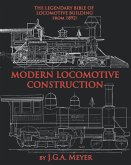A History of the Eastern Railway rediscovers the lost railway lines of Prussia (the "Ostbahn") and the locomotives that operated on them. It also contains information about some of the little-known railway mail postmarks from the period 1848 to 1945. The first chapter of this volume explores the politics and the construction of a state-owned railway, as well as the designs and drawings of the first parts of the route by early pioneers of railway engineering. Later chapters trace a railway mail journey by steam train from Berlin to the Russian border and beyond, into the occupied Baltic States and Ukraine. There are detailed descriptions and illustrations of some of the magnificent steam locomotives that ran on the network, as well as the narrow-gauge steam locomotives. The author covers some of the activities at the key stations, the birth of the railway companies, their management, and the amalgamations and nationalisation of private routes, from 1852 to 1889. From 1889 to 1945, wars brought changes to railway management culminating in the companies' surrender and dissolution. Included is an account of the author's family escaping in a railway mail car from an advancing Russian Army, leaving behind their home and livelihood. The written content and the material presented here are appearing for the first time in the public domain. Contributors include knowledgeable members of the Railway Post Office Society in Germany.








